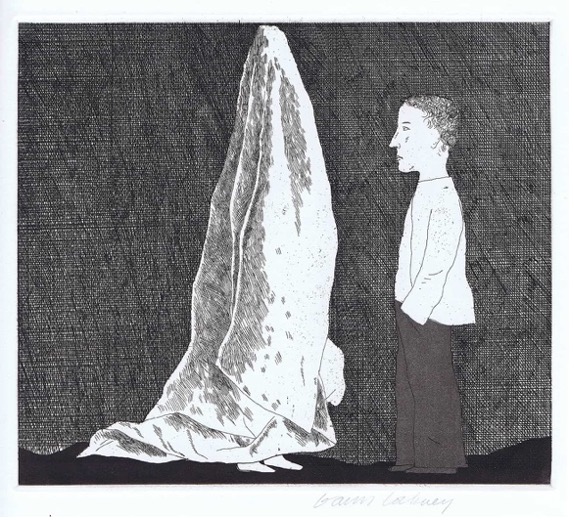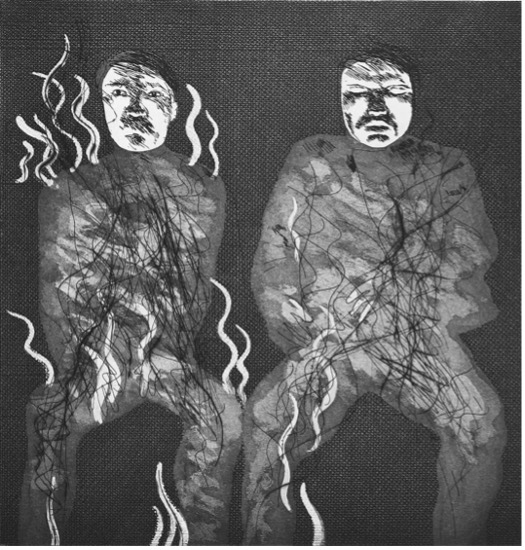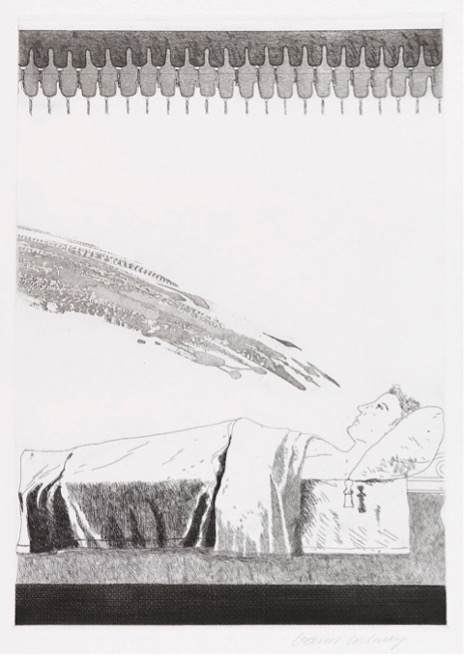By Anna Schmalz
Bruno Bettelheim was one of the first scholars to recognize the psychological importance of fairy tales. He claimed that the magic in fairy tales conformed to a child’s animistic worldview and gave them the tools to answer complex questions about identity and their place in the world (Bettelheim 45). But fairytales have more to offer than just magic, fantasy, and escapism. They also force children to confront difficult existential truths about life and what it means to be human. One fairytale in particular, “The Story of the Youth Who Went Forth to Learn What Fear Was” by the Grimm Brothers, specifically addresses the role of fear in the human condition. Artist David Hockney added a visual element to this tale by drawing scenes that had the greatest emotional impact on him. By comparing the tale and the etchings, I will argue that just as the pleasant and magical parts of fairy tales serve a purpose by inspiring children’s imaginations, the scary and unpleasant parts of fairy tales teach children about fear and the human condition.
In “The Story of the Youth Who Went Forth to Learn What Fear Was,” the protagonist lacks a fundamental human quality – fear. The father constantly points out the boy’s deficits by comparing the protagonist to his brother. The boy exclaims, “They are always saying: ‘It makes me shudder! It makes me shudder!’ It does not make me shudder… That, too, must be an art of which I understand nothing” (Grimm and Grimm 269). Unlike his smart and resourceful brother, the protagonist cannot experience fear. Bettelheim writes, “Since polarization dominates the child’s mind, it also dominates fairy tales. A person is either good or bad, nothing in between. One brother is stupid, the other is clever” (Bettelheim 9). Although the polarization Bettelheim describes is heavy-handed, it allows this particular tale to emphasize fear as an innate part of being human. Without it, the boy is inferior.
The structure and polarization of fairy tales allow the stories to succinctly address complex existential dilemmas. Bettelheim notes, “It is characteristic of fairy tales to present an existential dilemma briefly and pointedly. This permits the child to come to grips with the problem in its most essential form” (Bettelheim 8). Appropriately, the existential dilemma presented in “The Story of the Youth Who Went Forth to Learn What Fear Was,” is what it means to be human. The tale presents fear not only as a precursor to intelligence and competence, but a variety of other human emotions, as well. In his frustration, the boy’s father sends the protagonist to live with the church’s sexton, who offers to teach the boy what it means to feel afraid. The sexton disguises himself as a ghost and hides in the bell tower with the intention of scaring the boy. Instead of fleeing, the boy pushes the sexton down the stairs and breaks his leg. When the boy’s father receives word of the accident and confronts his son, the boy expresses little remorse for his actions: “Father… do listen to me. I am quite innocent. He was standing there by night like one intent on doing evil. I did not know who it was, and I entreated him three times either to speak or to go away” (Grimm and Grimm 271). Just as the boy is lacking the human emotion of fear, he is also lacking the human emotion of empathy.

Fig. 1. David Hockney, The Sexton Disguised as a Ghost, 1969.
David Hockney visually represented the interaction between the boy and the sexton, which further illustrates the protagonist’s shortcomings and the existential themes in the tale. The protagonist’s combative stance and close proximity to the ghost convey his fearlessness. The written tale hints at the boy’s lack of empathy, but the etching communicates this visually through the boy’s cold expression. Bettelheim states, “The fairy tale simplifies all situations. Its figures are clearly drawn; and details, unless very important, are eliminated” (Bettelheim 8). Like the tale itself, the etching is simple and minimalistic. The blank background trains the viewer’s focus on the figures, but even the figures themselves are plain and nondescript. And yet, the frank nature of the drawing allows it to foreshadow the supernatural horror that will define the rest of the tale. The boy coming face-to-face with a ghostly figure is his first of many brushes with death, the supernatural, and the afterlife.
Just as “The Story of the Youth Who Went Forth to Learn What Fear Was” presents fear as an essential part of being human, it also presents mortality and death as an unavoidable dimension of the human experience. After the boy’s father disowns him, a stranger suggests that the boy sits under a tree containing seven hanged men if he wants to experience fear. While the sexton’s disguise made him appear dead and other-worldly, the sexton was still very much alive. Now, the boy is confronting death explicitly. When night falls, the boy makes a fire, unties the seven bodies, and situates them around the fire with him. When the clothes of the dead men ignite, the boy tells them, “Take care, or I will hang you up again” (Grimm and Grimm 272). In addition to lacking fear, the boy also lacks the ability to distinguish between living and dead beings. By extension, he lacks the existential fear of death and what awaits on the other side.

Fig. 2. David Hockney, Corpses on Fire, 1969.
David Hockney’s illustration of this scene expands upon the tale’s supernatural and existential themes. The etching of the burning corpses visually depicts what the tale only hinted at: hellfire. The corpses catching fire symbolizes hell-like punishment for their misdeeds, addressing the existential question of what awaits for humans after they die. But since the boy cannot differentiate between living and dead, he cannot comprehend the spiritual dimension of life. In fact, the image holds a mirror up to the protagonist himself. He is so sorely lacking a human element that he does not view the corpses as any different from himself.
The tale presents the supernatural side of life as real, immediate, and part and parcel of the human experience. A wealthy king promises his daughter’s hand in marriage to anyone who can spend three nights in his haunted castle. The boy accepts the king’s offer, hoping that he will finally learn how to shudder. After a series of situations that include giant black cats, a dismembered corpse, and the boy’s dead cousin fail to make the protagonist fearful, a large man later identified as a spirit confronts the protagonist. The spirit tells him, “You shall soon learn what it is to shudder, for you shall die” (Grimm and Grimm 275). But even this experience fails to make the boy afraid as he easily subdues the spirit, marking the end of his three nights in the castle. The boy’s lack of fear indicates a lack of appreciation for death. Just as the boy could not understand the corpses were dead, he cannot fathom his own mortality.

Fig. 3. David Hockney, Inside the Castle, 1969.
David Hockney’s etching adds another dimension to this scene. The position of the boy’s head and his harsh facial expression are nearly identical to the earlier drawing of him and the sexton. But unlike in the previous etching, where the boy stood face-to-face with the ghostly figure, the boy now sits with his back to the spirit. His posture communicates his inability to recognize death and, by extension, the spiritual element of life. Just as his back is turned to the spirit who plans to kill him, his back is also turned to his own mortality.
While the tale addresses the emotional and spiritual dimensions of life by describing what the protagonist lacks, it also addresses the physical element of being human. Once the boy subdues the spirit, the king informs him that he will marry the princess. The boy responds to this information by saying, “That is all very well… but still I do not know what it is to shudder” (Grimm and Grimm 276). The princess grows increasingly aggravated by her husband’s obsession with shuddering, which robs him of his ability to appreciate their wedding or their marriage. Finally, the princess’s chambermaid throws a bucket of cold water with minnows on the boy, at which point he exclaims: “Oh, what makes me shudder so? – what makes me shudder so, dear wife? Ah! now I know what it is to shudder” (Grimm and Grimm 276). In the tale, fear is always operationalized as the somatic sensation of shuddering. Just as the emotion of fear is an integral part of the human experience, so are the corporeal sensations associated with it.

Fig. 4. David Hockney, Cold Water About to Hit the Prince, 1969.
David Hockney’s etching further conveys the boy’s lack of humanness. In the drawing, the bed looks like a coffin, suggesting that the boy’s lack of fear effectively renders him dead. Just as he did not view the hanged corpses as any different from himself or exhibit any awareness of his own mortality, he is essentially dead to the world and oblivious to the full range and depth of the human experience. Both literally and figuratively, the boy is asleep. Even though the drawing depicts the boy seconds before the cold water awakens him – when he should be asleep – his eyes are open. The cold water allows the boy to experience the physical sensation of shuddering for the first time, opening his eyes to the dimension of life to which he was previously oblivious.
Although “The Story of the Youth Who Went Forth to Learn What Fear Was” addresses deeper existential questions about what it means to be human emotionally, spiritually, and physically, it is also a horrifying tale. Reminiscent of a ghost story told around the campfire, the tale includes death, gore, and murder. Although a fairy tale in its form and structure, “The Story of the Youth Who Went Forth to Learn What Fear Was” differs greatly from popular conceptions of the fairy tale genre which are decidedly more rosy – filled with fantasy, wish-fulfillment, and a promised happily ever after. In this case, the happy ending is merely a boy being released from his torment by learning how to experience fear. Why read a tale of this nature to children?
First and foremost, fear serves an evolutionary purpose. For all sentient beings, the emotional and physical sensation of fear allows them to avoid or overcome immediate threats – lack of food, a predator, or a natural disaster. Under the right circumstances, fear is motivating instead of paralyzing. However, psychologists and evolutionary biologists suggest that one type of fear is unique to the human experience – the existential fear of death. Terror Management Theory posits that humans cope with this existential fear of death “through the collective construction and maintenance of cultural worldviews” (Landau et al. 478). Fairy tales are one iteration of this cultural worldview and allow readers to confront death in a safe and sometimes pleasurable way. Although “The Story of the Youth Who Went Forth to Learn What Fear Was” is gruesome and unsettling, the situations in which the protagonist finds himself also border on comedic and absurd. And after all, it is just a story that ceases to exist once the reader closes the book.
Finally, scary stories themselves are valuable. Bruno Bettelheim notes that, “Many parents believe that only conscious reality or pleasant and wish-fulfilling images should be presented to the child – that he should be exposed only to the sunny side of things. But such one-sided fare nourishes the mind only in a one-sided way, and real life is not all sunny” (Bettelheim 7). In the same way that the protagonist in the tale was lacking a human element due to his inability to shudder, parents similarly rob children of the full range of the human experience when they refuse to expose children to scary stories. Although fear can feel paralyzing, fairy tales enable readers to confront the harsh realities of life in a manner that is empowering instead of demotivating. Maria Tatar notes that fairy tales “open up a theater of possibilities and create an unparalleled sense of immediacy, at times producing somatic responses with nothing but words” (Tatar 56). Physical sensations are essential to the way readers experience fairy tales, no different from the way “The Story of the Youth Who Went Forth to Learn What Fear Was” presents physical sensations as an integral part of the human experience. Ultimately, the human experience encompasses a range of emotions and circumstances, both pleasant and unpleasant. But exploring death, loss, and fear through stories prepares readers for the difficult feelings and experiences they will inevitably encounter in real life.
Works Cited
Bettelheim, Bruno. The Uses of Enchantment. Vintage Books, 1989, Archive.org, https://archive.org/details/usesofenchantmen00brun/page/8/mode/2up.
Grimm, Jacob, and Wilhelm Grimm. “The Story of the Youth Who Went Forth to Learn What Fear Was.” Grimms’ Fairy Tales, Project Gutenberg, Champaign, IL, 2001, pp. 269–276, https://www.gutenberg.org/files/2591/old/grimm10.pdf.
Hockney, David. “Cold Water About to Hit the Prince.” Gerrish Fine Art, 1969, https://gerrishfineart.com/product/cold-water-about-to-hit-the-prince-the-boy-who-left-home-to-learn-fear/.
Hockney, David. “Corpses on Fire.” Gerrish Fine Art, 1969, https://gerrishfineart.com/product/corpses-on-fire-the-boy-who-left-home-to-learn-fear-2/.
Hockney, David. “Inside the Castle.” Gerrish Fine Art, 1969, https://gerrishfineart.com/product/inside-the-castle-the-boy-who-left-home-to-learn-fear/.
Hockney, David. “The Sexton Disguised as a Ghost.” Gerrish Fine Art, 1969, https://gerrishfineart.com/product/the-sexton-disguised-as-a-ghost-the-boy-who-left-home-to-learn-fear/.
Landau, Mark J., et al. “On the Compatibility of Terror Management Theory and Perspectives on Human Evolution.” Evolutionary Psychology, vol. 5, no. 3, 1 July 2007, pp. 476–519., https://doi.org/10.1177/147470490700500303.
Tatar, Maria. “Why Fairy Tales Matter: The Performative and the Transformative.” Western Folklore, vol. 69, no. 1, 2010, pp. 55–64. JSTOR, http://www.jstor.org/stable/25735284.